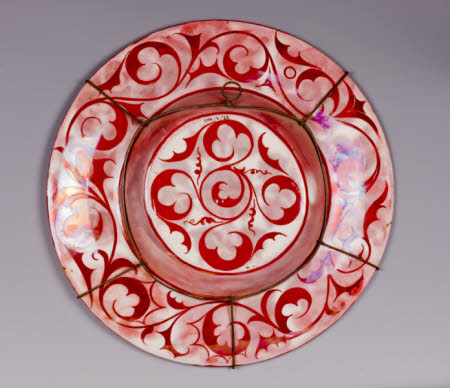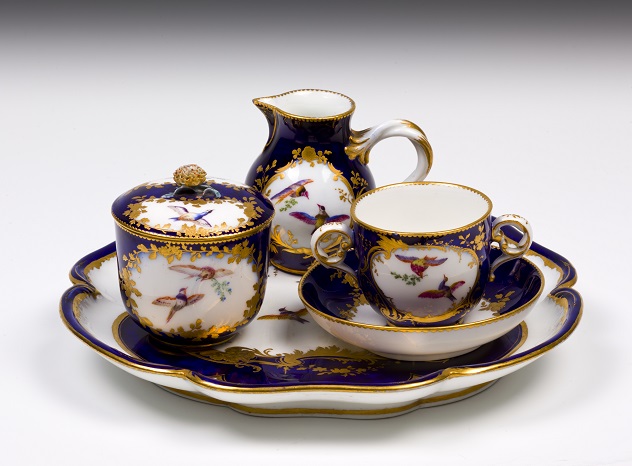Charger
William Frend De Morgan (London 1839 - London 1917)
Category
Ceramics
Date
circa 1875 - 1885
Materials
white earthenware (ironstone), painted in ruby-red and gold lustre
Measurements
50 x 435 mm
Place of origin
Chelsea
Order this imageCollection
Carlyle's House, London
NT 263359
Summary
A William De Morgan lustre-painted earthenware dish with heraldic lion, decorated at the Orange House Pottery, 36 Cheyne Row, Chelsea or Merton Abbey, Surrey, England, c.1875-85.
Full description
Multi-talented William De Morgan (1839–1917) was an inventive ceramic designer who with great verve mastered the elusive historic techniques of tin-glaze and lustre painting, which he applied first to tilework and later to vases and dishes. In 1873, he became a neighbour of the Scottish essayist and historian Thomas Carlyle (1795–1881). Carlyle had sown the seeds of the Arts and Crafts movement in an essay, ‘Signs of the Times’, published in 1829, an attack on the dehumanising effects of modern machinery and the loss of handicraft. This had a major influence on both John Ruskin and William Morris. Carlyle lived in a Queen Anne terrace house at no. 5 (now no. 24) Cheyne Row, in the heart of Chelsea, and De Morgan rented the Orange House, at no. 36, for his tilemaking workshop and showroom. Originally a stained-glass artist, De Morgan had become fascinated by lustrous metallic glazes, which led to his celebrated rediscovery of the art of lustre decoration in 1874. The technique, invented in the ninth century in the Middle East, had been lost in Europe since the late sixteenth century. To achieve the effect, metallic oxides of silver and copper mixed with white clay and water were painted over the glaze and fired at a low temperature in a reduction (oxygen-starved) ‘muffle’ kiln. Afterwards, the clay was rubbed away, revealing a thin, lustrous film of either gold or a bright ruby-red colour, which included more copper, on the surface of the glaze. He first applied this technique to hollow wares after moving to Merton Abbey, Surrey – near Morris & Co.’s workshops – in 1882. This dish at Carlyle’s House is painted in ruby-red and gold lustre with an heraldic rampant lion surrounded by Gothic foliage and beribboned Renaissance-style cherubic masks. It is impressed ‘J.H. Davis’, the mark used by the potter John Heath Davis (active 1875–91) of Hanley, Staffordshire. De Morgan frequently purchased blanks from commercial potteries in Staffordshire. Studio assistants pricked through the lines of his design drawings, placed them over the ceramic to be decorated and dusted powdered charcoal through the pinholes, forming outlines for the painters to follow. This historic technique, known as ‘pouncing’, allowed a drawing by De Morgan to be reused several times. A working drawing for the lion on this dish survives in the Victoria and Albert Museum. In 1867, following the death the previous year of Carlyle’s wife, Jane, his niece Mary Aitken Carlyle (1848–95) became his companion. She married her cousin Alexander Carlyle (1843–1931), Thomas’s nephew, in 1879. Mary befriended De Morgan, who shortly after 1873 extinguished a fire in Carlyle’s house. The dish may have been acquired before Carlyle’s death in 1881; however, the bold design of undulating swirls on the reverse is typical of the Merton Abbey period (1882–8). When Carlyle’s House Memorial Trust opened no. 5 Cheyne Row in 1895 as a museum with many of the original furnishings, the dish was not included. It is first recorded in 1932 in a sale at Sotheby’s of items ‘formerly the Property of Thomas Carlyle … and now sold by order of the executors of his nephew, Alexander Carlyle’.Alfred Reveirs-Hopkins, an authority on English furniture, bought it for the museum. The dish retains its wire mounts suspending the lion perpetually running forward on all fours, and looking back over his shoulder. Text adapted from Patricia F. Ferguson, Ceramics: 400 Years of British Collecting in 100 Masterpieces, Philip Wilson Publishers, 2016.
Provenance
Purchased at Sotheby's, 14 June 1932, Lot 245, by A. E. Reveirs-Hopkins, who presented it to the Carlyle's House Memorial Trust.
Marks and inscriptions
‘J. H. Davis’ impressed for John Heath Davis,Trent Pottery, Eastwood, Hanley, Staffordshire, c.1875-85.
Makers and roles
William Frend De Morgan (London 1839 - London 1917) , potter William Frend De Morgan (London 1839 - London 1917) , artist
References
Ferguson 2016: Patricia F. Ferguson, Ceramics: 400 Years of British Collecting in 100 Masterpieces, Philip Wilson Publishers, 2016, pp. 210-11


